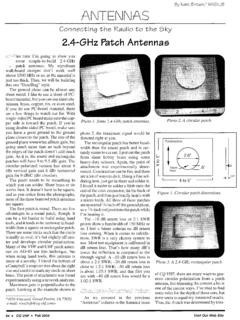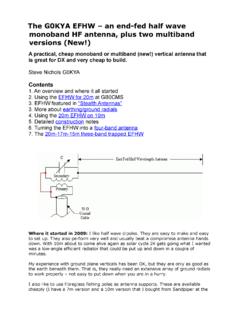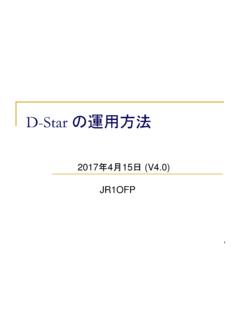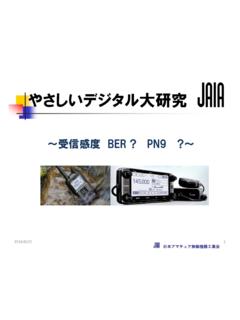Transcription of D-Star: New Modes for VHF/UHF Amateur Radio - …
1 30 Jul/Aug 200318225 69th Pl WLynnwood, WA New Modesfor VHF/UHFA mateur Radio , Part 1By John Gibbs, KC7 YXDOur friends in jarl have created a newdigital communication standard. Let s look attheir new system, and what s in it for article is the first in a three-part series describing and ana-lyzing a new communicationstandard developed by the JapanAmateur Radio League ( jarl ). Thefirst part focuses on the advantagesof upgrading our VHF/UHF equip-ment to a new, more capable second article in the series ad-dresses the technical design consider-ations of a digital voice and high-speeddata system in the VHF/UHF spec-trum.
2 The third, and final, article dis-cusses the D- star standard and howit addresses the needs and technicalissues raised in the two previous has developed a new openstandard for VHF/UHF digital radiocalled D- star . The system supportsboth digitally modulated voice trans-mission and data transmission, includ-ing Internet connections, at DSL a time when the third-generation(3G) cell phone proposals for high-speeddata have been severely delayed,D- star presents Amateur Radio op-erators with the opportunity to bringthe Internet Age to mobile and have been fortunate to be one ofthe first hams to see and use the proto-type transceivers of this new Amateurcommunication system.
3 Therefore, Iwould like to take this opportunity toshare some of the knowledge and expe-rience I have gained. In this article, Iwill present the objectives of the newJARL D- star system and provide aglimpse of the capabilities of this newsystem and the engineering tradeoffsthat went into the system design. I hopeyou will find it interesting both in de-veloping an understanding of this sys-tem and as an insight into the designprocess of a digital Radio of the major goals of D-STARis that it be an open system. Thisseries of articles contains enough sys-tem details for a skilled ham to de-velop a homebrew D- star digitalvoice you are interested in this system,you may soon have a chance to try ityourself.
4 Because the FCC encouragesthe Amateur Radio community to de-velop new digital Modes , the US hasthe regulatory structure in place forhams to use an all-digital voice andhigh-speed data Radio system withoutspecial licensing or permits. US hamswill therefore be the first in the worldwith the opportunity to use the newD- star system illustrated in Fig readers of QEX know thathams have been experimenting withdigital In the US, the FCC en-courages hams to continue such ex-perimentation to demonstrate ourstewardship of our spectrum. In addi-tion to individual efforts, AmateurRadio organizations have also beenpromoting digital Radio .
5 For years,TAPR has focused exclusively on ad-vancing the state of the art in Ama-teur Radio digital ARRL has increased its efforts inthis area by sponsoring the establish-ment of Technology Task Force Work-ing Groups on digital voice, high-speedmultimedia and software addition to the efforts of indi-vidual hams and their organizations,one manufacturer has already intro-duced a digital voice option to handheldVHF/UHF radios. Unfortunately, these1 Notes appear on page , 12:14 PM30 Jul/Aug 2003 31radios are of limited usefulness becausethe necessary repeater infrastructurefor VHF/UHF digital voice operationswith these radios does not exist.
6 Theseradios will not work through existinganalog repeaters and the necessarydigital repeaters have not been devel-oped. Early on in the D- star planning,the jarl recognized that developingVHF/UHF digital capabilities also re-quires developing new standards fordigital voice repeaters and the links be-tween HistoryThe D- star standard not only ad-dresses the needs of VHF/UHF voiceand data communications with mobileand handheld radios, but also providesthe standards for repeater-to-repeaterlinking and Internet access. It was clearthat developing and testing such a com-plex system would take many man-years of engineering and testing.
7 Theefforts that would be required to achievethis in a timely manner would far ex-ceed any reasonable expectations ofvolunteer ham labor, no matter howdedicated. So, the jarl contracted withthe Amateur Radio manufacturerICOM to develop and evaluate D- star prototype hardware. D- star has beenunder development since 1998 and thesystem operation has been proven in laband field tests. The result of all thisdevelopment effort is about to bearfruit. The jarl expects to finalize theD- star standard this D- star mobile transceivercalled the ICOM ID-1 was used forfield trials in the Tokyo area (see thecover photo on this issue) and shownat three US Amateur Radio shows:Dayton Hamvention 2002 and 2003and the Digital Communication Con-ference (DCC) in Denver last then, repeaters and microwavelinks have been developed and are cur-rently available on a limited basis toapplication developers in the US.
8 Allthese D- star compatible componentswill soon be shipping in quantity, andwe expect that other manufacturerswill be shipping D- star -compatibleradios in the VHF/UHF SystemPropertiesTo replace any existing system witha new standard, there must be compel-ling reasons for incurring the expenseof new equipment. So it is good to startthe discussion of D- star with a lookat the capabilities and limitations of ourexisting VHF/UHF Amateur communi-cation systems in Tables 1 and 2. To dothis, let us look at the capabilities of arepresentative voice repeater systemthat covers the Pacific Northwest andbeyond: the Evergreen Evergreen Intertie connectsmore than 23 repeaters by full-duplexUHF Radio links that are transparentto the user.
9 From my location, thereare two main links in the system,a North-South link that connectsWestern Washington and Oregon andan East-West link that crosses theCascade Mountains and connects tocities in Eastern can control switches usingDTMF tones to connect repeaters tothe link. The way this particular sys-tem is configured, a minimum of threeswitches must be set by a user or con-trol operator to connect two a more-extreme case, sevenswitches must be set to talk from Se-attle repeater K7 NWS to Portland re-peater KJ7IY. Of course, each switchthat connects to the next link may bealready in use, so it can be difficultfor a user to establish such links if thesystem is heavily a repeater link, only one con-tact can be held on a link at a is, unlike the telephone system,there is no multiplexing on links.
10 If alink is in use or out of service, there isno way to link the repeaters unless analternate path is difference from the tele-phone trunk system lies in how a linkis established. In the telephone sys-tem, the system automatically picksthe link based on the call destinationand the trunk lines currently avail-able. In the Evergreen Intertie, theuser must determine the logical paththrough the repeater links and toknow the DTMF codes for each of Radio packet systems of-fer an analogous set of featuresthrough dedicated packet nodes (sim-plex repeaters.) Packet Radio is usedto transfer data (for example, com-puter files) and for keyboard might even be possible to have adigital voice contact on a 9600-bpssystem.

















